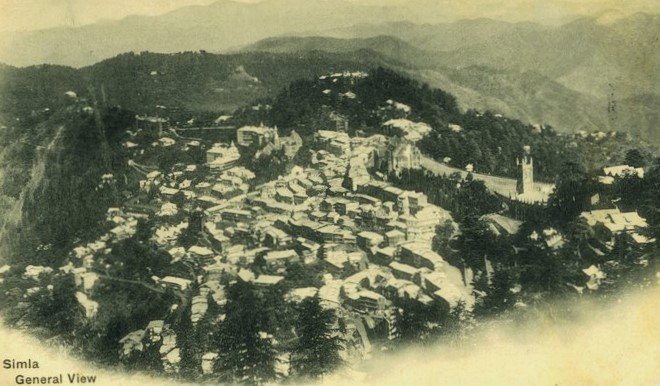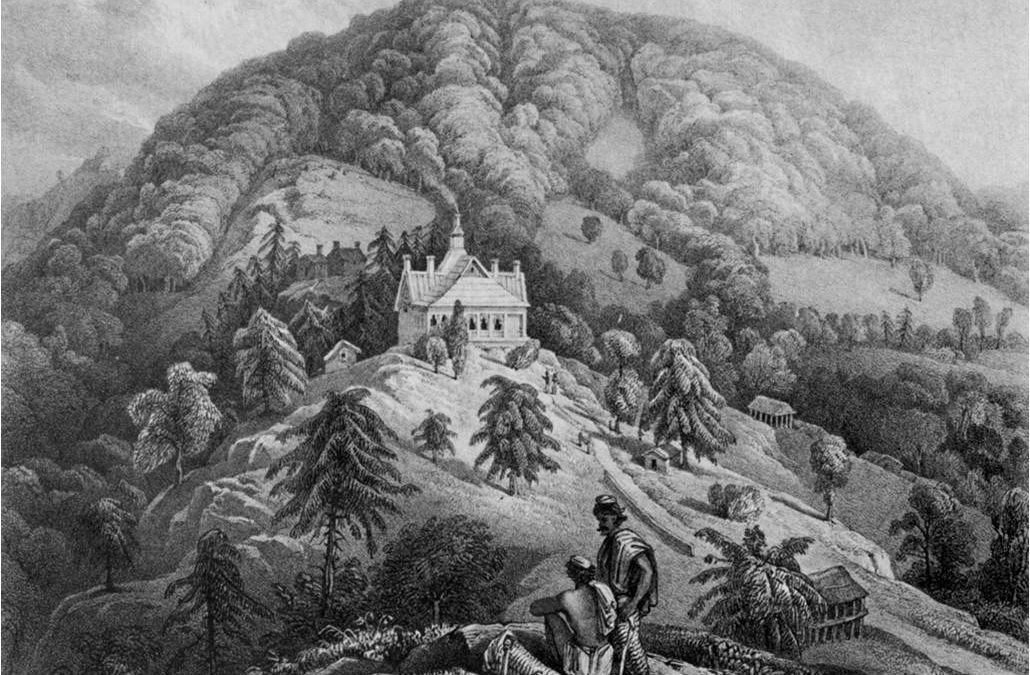In 1870 Mr. W. H. Carey mentioned in his Simla Guide that Simla drives its name from a house called ‘Shyamelay,’ built by a fakir – a sage, on the slopes of Jakhoo hill. The hills people also pronounced it probably as ‘Shimlah,’ or ‘Shumlah’
Originally, the village was situated where the present days Lower Bazaar is, between the building of ARTRAC and Combermere Bridge. During the Anglo-Gurkha war, no one noticed this village but after the war was over a British officer while moving a Gurkha troupe to Kotgarh, stopped here and realized that the climate of this place resembled Scotland. The officer liked the cool temperature of the place.
The first picture made of Shimla was drawn on the spot in Shimla in 1825 by Captain J. Luard. It was published in London in 1833 in his book journal ‘Views of India from Calcutta to the Himalayas’. In the preface he says, ‘all who have visited this charming spot have experienced Major Kennedy’s kindness and hospitality’.
A small thatched-roof cottage was built by Captain Ross in 1819 but Kennedy House named after Captain Kennedy who commanded from Subathu, built the first permanent house in Shimla.
The Hospitality of Captain Kennedy
Most of the people in the initial years of the building of Shimla stayed and dined with Captain Kennedy. In 1832 Captain Mundy – the Aid-de-Camp of Lord Combermere – 1828, wrote about Shimla, ‘The political agent established a summer residence at Simla, a name given to two or three miserable shepherds’ huts situated 24 miles north-east of Subbatoo beyond the British dominions, and in the territory of a native Ranee or feudal baroness, for the ruler of a small uncultivated cluster of mountains can scarcely be dignified with the title of queen. The climate of Simla soon became famous: invalids from the plains resorted there, and built houses, instead of breaking up establishments and sailing for the Cape of Good Hope with little hope of reaching it; and finally Simla was rendered fashionable by the governor-general, Lord Amherst, who resided there with his family for several months and brought back to Calcutta rosy complexions and some beautiful drawings by Lady Sarah Amherst to attest the healthful and picturesque properties of the spot.’
Captain Mundy left Shimla on 20th October 1828 and never returned. Before leaving this place he wrote,‘ I cannot doubt but that Simla will rise in importance every year as it becomes better known. Its delightful climate is sure to recommend it for invalids; and its beautiful scenery, healthful temperature, and above all the relaxation which they will there enjoy will induce the governors-general and commanders-in-chief to resort there, during the hot months, in their official tours through the upper provinces’.

Three Gerard Brothers
Later Mr. A. Wilson, the author of ‘Abode of Snow’ says that the station was noticed for the very first time by three Gerard Brothers who were on the survey of the Satluj Valley. Their diary, dated August 30th, 1817, says ‘Simla, a middling sized village where a fakir is situated to give water to travelers . . . We encamped on the side of Jakko and had a very extensive and beautiful prospect.’
They were Lieutenant (afterward Captain), Alexander Gerard, 27th Native Infantry, Lieutenant (afterward Captain) Patrick Gerard and Assistant Surgeon James Gilbert Gerard, Bengal Medical Service, who died at Sabathu on 31st March 1835. Patrick and James served with the 1st Nuassirie battalion at Sabathu. The three brothers camped somewhere on the slope of Jakhu hill near present days Holly Lodge. In those days it was dense forest the planning of Simla was nowhere around. Later in 1841, the older Gerard published a book called ‘Travels to Kunoowar’ on his travel to these valleys called
In his narrative of ‘A Journey from Cawnpore to the Borrendo Pass,‘Major Sir William Lloyd tells, ‘The then splendid forests which clothed the sides of the Simla hills made a considerable impression upon the travelers, who after seeing a sunrise from Jakko and taking various observations journeyed on to Mahasu and thence into the interior. It is impossible that Simla and its sublimity can ever be effaced from our minds’.
The Resort of the Rich
The following text is from the official history of the Simla ‘ilaqa’ or district up to 1850, given in the Settlement Report on the Simla district by Colonel E. G. Wace (1881-3),
‘The lands forming the ‘ pergannah ‘ and the present station of Simla originally belonged conjointly to the Maharaja of Patiala and the Rana of Keonthal. As early as 1824 Eurojjean gentlemen, chiefly invalids from the plains, had, with the permission of these chiefs established themselves in this locality, building houses on sites granted them rent-free, and with no other stipulation than that they should refrain from the slaughter of kine and the felling of trees, unless with the previous permission of the proprietors of the land. The station became favorably known as a sanitarium, and in 1830 the government directed that negotiations should be entered into with the chiefs of Patiala and Keonthal for as much land as was deemed sufficient to form a station. Accordingly, Major Kennedy, the then political agent, negotiated an exchange with the Rana of Keonthal for his portion of the Simla hill, comprising thirteen villages, and yielding an estimated revenue of Rs. 987, making over to the Rana the ‘pergannah’ of Rajeen, yielding an annual revenue of Rs. 1,289, which had been retained by us on the first conquest of these hills, as its position was considered to afford a good military position. A portion of the retained pergannah of Bharaulie, consisting of seven small villages, was at the same time made over to the Maharaja of Patiala in exchange for his portion of Simla which was included in his territory yielding an estimated revenue of Rs. 245 per annum’.

The Arrival of Lord Combermere
Captain Mundy, who first reached Simla on May Day 1828, thus describes his arrival, ‘On reaching Simla we pitched our tents for the night and hurried to change our entire suite of white linen for a costume more suited to the temperature of 61°, which to us appeared almost inclement: indeed it was a dreadful night. I was completely drenched in my bed by the rain which fell in torrents, and the wind was so violent and the situation of our tents so exposed that I lay awake in momentary expectation of being blown away bodily into the valley 500 feet below. We found Lord Combermere with his surgeon and aide-de-camp established in Captain Kennedy’s summer residence (Kennedy House), and the rest of the staff were either accommodated in the already existing houses or busily employed in the building — residing in the meanwhile in tents. The frequent clash of axe and hammer give evidence of the diligence with which they are laboring to provide roofs for themselves before the rains set in — nor have they much time to spare — . . . . Communication between the several residences and the bazaar is secured by well-formed roads, which, though narrow, are tolerably safe for sober passengers. However, during our sojourn there, more than one neck was put in jeopardy by dark nights and hospitable neighbors’.
The First Step towards the Improvement of Shimla
Later in 1829 Lord Comberemere built a bridge to the eastern end of then Shimla, now near the lift. That bridge became the first step towards the improvement of the town. The water channel on which the bridge was built provided water to the village. Lord also built a water tank under the bridge. What happened to that tank no one knows. Now the water channel is full of filth thrown by the hotels around and by the tourists and one does not realize that he is standing on a bridge.
A French traveler Victor Jacquemonth came to Shimla in 1831 and mentioned this place as ‘the resort of the rich, the idle, and the invalid’. After Captain Kennedy was followed by some of his close friends and to all of them the climate looked suitable. So they hired the locals to fell hundreds of trees to create space for the houses.
By 1931 Shimla had got nearly sixty houses all scattered around on the hilltops of in the forests, forming considerably a large size European village in the Himalayan slopes.

Written by
Sumit Raj
Better known as Summit is the founder of Shimla Walks and a qualified tourism professional from Delhi University. Summit is a published author with six books to his credit, now. His seventh on titled as ‘Shimla Walks’ is on the way and to be released soon. Summit loves Himalaya and says that ‘Mountains travel in his veins with blood’.
One of his books that he wrote on Kalka Shimla Railway, named as A Journey to Shimla – by Toy Train can be read on Kindle.
Contact Him : +917018703170, +91 9459519620
WhatsApp : +91 7018703170


